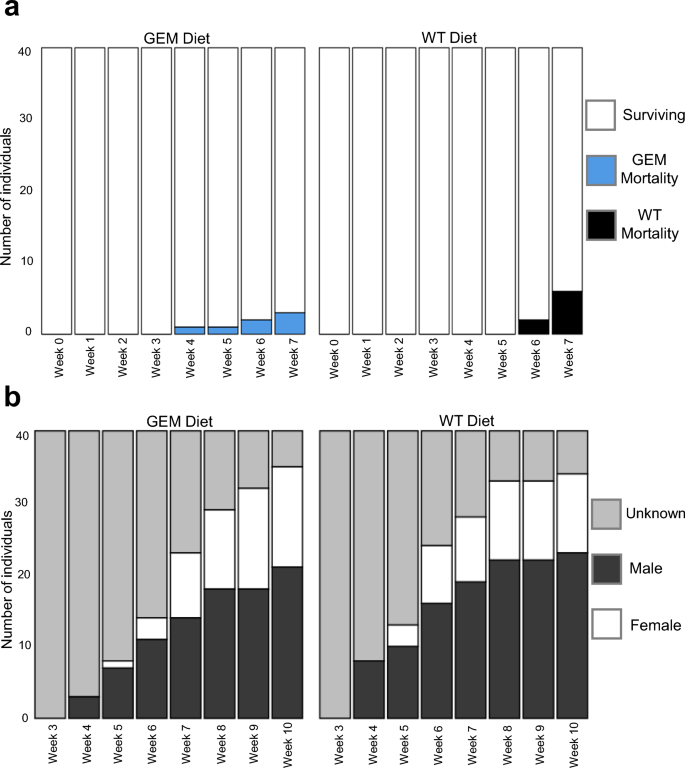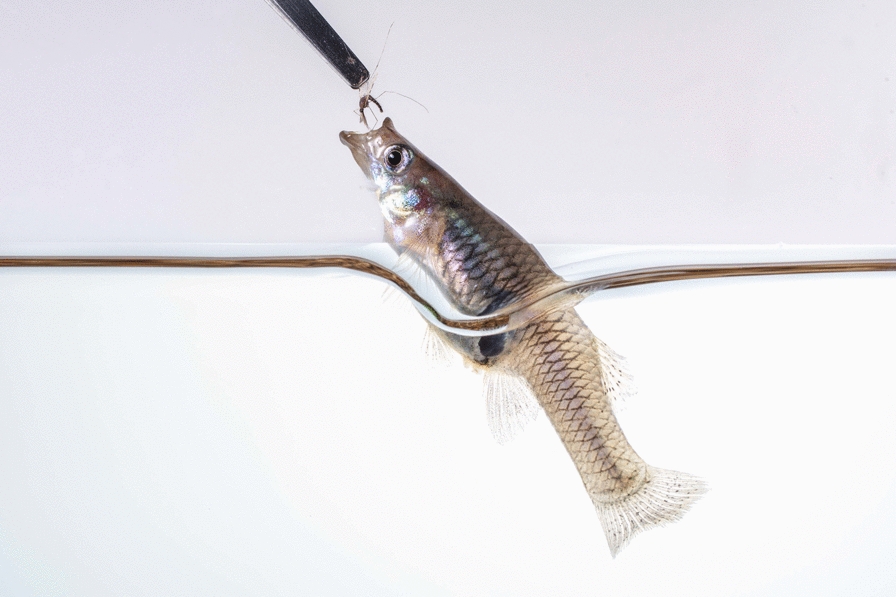Genetically engineered Anopheles coluzzii
The genetically engineered AcTP13 strain of An. coluzzii used in these experiments was developed and described by the James lab at UC Irvine [8]. The GEM strain was initially created via introgression of a drive system into the Mopti An. coluzzii strain (MRA-763) from BEI (BEI Resources, Manassas, VA, USA); therefore, the Mopti strain was used as the WT control for the studies described in this report. The AcTP13 GEM is equipped with two effector genes that produce single-chain variable fragment monoclonal antibodies that target Plasmodium falciparum at the ookinete and sporozoite stages [8]. These effector genes are most strongly expressed in adult females following a blood meal [8], and therefore adult semi-gravid or gravid An. coluzzii were used for predator diets.
Predators
Immature stages of two predator species, the mosquitofish Gambusia affinis (Fig. 1a) and the bold jumping spider Phidippus audax (Fig. 2a) were selected for this experiment. Immature stages were used because growth during this period occurs rapidly and predictably as individuals progress toward sexual maturity.
Gambusia affinis morphological characteristics and measurements. a Juvenile G. affinis of indistinguishable sex. b Fish length measured dorsally on a 1 mm × 1 mm grid from the tip of the mouth to the base of the caudal fin (yellow arrow). c Sexual differentiation in G. affinis shown in an adult female (left) displaying a black gravid spot and larger rounded body and adult male (right) displaying an elongated gonopodium (anal fin) and smaller narrow body (a and c not to scale)

Phidippus audax characteristics and measurements. a Juvenile P. audax showing no phenotypic sex characteristics. Defined measurements of (b) carapace width and (c) anterior median eye diameter
Mosquitofish: Gambusia affinis
Gravid adult G. affinis fish were acquired from the Sacramento-Yolo Mosquito and Vector Control District (8631 Bond Rd Elk Grove, CA 95624). Each female was isolated in a 6-L birthing tank filled with conditioned tap water and equipped with an air stone for oxygenation. Each gravid female was placed in a screened-off birthing chamber within the tank. The screen prevented cannibalization by allowing fry to swim through while containing the adult female [41]. The adult female was removed from the chamber after giving birth. Fry were raised communally with their siblings for the first 2 weeks of life and fed Hikari First Bites Fish Food Granules (Petco, San Diego, California, USA) ad libitum daily. After 2 weeks, offspring from two separate mothers were divided evenly between two assigned diet groups, with offspring totaling 40 individuals per diet group. Fish were then reared individually in 700 ml plastic containers filled with 500 ml of conditioned tap water equipped with an air stone for oxygenation and a screened lid to prevent jumping.
Although adult G. affinis will readily feed on adult mosquitoes from the water’s surface, attempts to feed live adult mosquitoes to juvenile fish were unsuccessful owing to the juveniles’ small size. The G. affinis diet was designed to include high levels of expressed GEM antibodies rather than accurately reproduce predatory–prey dynamics between G. affinis and An. coluzzii. Therefore, adult mosquitoes were lyophilized and mixed with Hikari First Bites Fish Food Granules (Petco, San Diego, CA, USA) to prepare the G. affinis diet. Cages of adult mosquitoes containing a mixture of gravid, nongravid, and male mosquitoes were used to prepare the diet. Anopheles were blood-fed the evening before G. affinis diet preparation began. Cages of unsorted live adults were placed in a −20 °C freezer for 30 min. Each cage of frozen mosquitoes was funneled into a 15 ml tube stored at −20 °C for a maximum of 2 h. Each tube was lyophilized for 24 h using a Labconco FreeZone 2.5 Plus lyophilizer (Labconco, Kansas City, MO, USA). To ensure that the final GEM and WT diet mixtures contained the same percentage of gravid female mosquitoes, three parameters were recorded: (1) the average mass of individual lyophilized male, nongravid female, and gravid female mosquitoes for each strain, (2) the ratio of mosquito types (gravid females, nongravid females, and males) within each cage, and (3) the total mass of lyophilized mosquitoes per cage. To determine the average mass of each mosquito type, 50 individual males, nongravid, and gravid females from each strain were lyophilized separately, and the average mass per individual of each type was calculated. Prior to lyophilization, subsamples of approximately 150 mosquitoes from each cage were sorted into males, nongravid females, and gravid females to estimate the fractional ratio of mosquito type per cage. Finally, after lyophilizing each cage, all lyophilized mosquitoes were weighed to determine the total cage mass.
$${{varvec{T}}}_{{varvec{G}}{varvec{F}}}=frac{{f}_{GF}}{left({overline{m} }_{M}cdot {f}_{M}right)+left({overline{m} }_{GF}cdot {f}_{GF}right)+left({overline{m} }_{NG}cdot {f}_{NG}right)}cdot C$$
The estimated total number of gravid females per cage ({({varvec{T}}}_{{varvec{G}}{varvec{F}}})) was determined using the average individual mosquito masses ((overline{{varvec{m}} })) and fractional ratio (({varvec{f}})) of males (({varvec{M}})), nongravid females (({varvec{N}}{varvec{G}})), and gravid females (({varvec{G}}{varvec{F}})), and the total mass of the lyophilized cage (({varvec{C}})). Approximately 16 cages of each mosquito strain were processed to produce a mosquito mixture containing 68% gravid females and 32% males and nongravid females by mass. Although the diet mixtures also contained males and nongravid females, the number of gravid females was used as the basis for dietary composition because the gravid females express the genetically engineered proteins of interest to this study. The final diet mixture was prepared by grinding the lyophilized mosquitoes and mixing them with fish food to create a formulation of 10 gravid females per 14 mg of powdered food mixture. This mixture was 40% gravid female, 20% nongravid female and male, and 40% fish food by mass.
Once per week, mass and length measurements were collected for each fish. A week zero baseline measurement was taken before beginning the experimental diet. To measure mass, each fish was transferred from its enclosure to a 30 mm petri dish containing water on a pretared scale. A net was used to transfer the fish to prevent excess water from altering the fish mass. Fish mass was recorded to the nearest 0.1 mg. After weighing, each fish was photographed on a 1 mm × 1 mm grid background to measure its standard length. Standard length [42] was measured dorsally from the tip of the mouth to the base of the caudal fin using ImageJ software (Fig. 1b) [43, 44].
During the 7-week experiment, fish were fed a GEM or WT mosquito food mixture twice per week, with fish food provided on all other days. The daily ration of mosquito food mix and fish food was adjusted weekly to approximately 25% of the average fish body weight. On average, fish consumed 14.5 gravid females per week. Water in each container was replaced prior to the twice-weekly mosquito feedings. Fish were monitored daily for mortality (Fig. 3a) and observed twice weekly for signs of sexual differentiation (Fig. 3b). Fish displaying a gravid spot were classified as female, while those with an elongated gonopodium were classified as male (Fig. 1c). After the initial 7-week period, fish were reared for an additional 3 weeks and fed Hikari fish bites to allow more individuals to achieve sexual differentiation (Fig. 3b).

Weekly measurements of G. affinis development metrics. a Cumulative mortality rates for genetically modified mosquito (GEM) diet group (left) or wild-type (WT) diet group (right) and (b) sexual differentiation for GEM diet group (left) or WT diet group (right)
Jumping spiders: Phidippus audax
Two gravid P. audax females were purchased from jumpingspidersforsale.com (Garden Grove, CA, USA). Each female was housed in a 101.6 mm × 101.6 mm × 128.6 mm enclosure and fed a diet of crickets and fruit flies twice per week. Hatchlings were kept in the same enclosure as the mother until they began to leave the nest, approximately 1 month after hatching. The 59 total hatchlings from two mothers were placed in individual enclosures and distributed evenly between the two diet groups. The sex ratio was initially unknown as juvenile male and female jumping spiders are morphologically indistinguishable (Fig. 2a).
Individual enclosures measured 12.5 × 5.5 × 5.5 mm and contained a Plaster of Paris substrate and cork bark affixed to one side. Small, screened ventilation holes were provided on the sides and lids of the container, with a larger plugged hole at the base of the enclosure to allow for the introduction of mosquito prey. Enclosures were sprayed with water three times per week. Prior to the start of the experiment, each juvenile spider was fed five fruit flies per week. A week 0 baseline measurement was taken before the initial introduction of GEM or WT mosquito diets.
During the experiment, spiders were exclusively fed ten live, half-gravid, female GEM or WT An. coluzzii mosquitoes once per week for 11 weeks. A total of 30 spiders were used for each diet group. Spiders and remaining mosquitoes were lightly anesthetized with CO2 and removed from their enclosures 48 h after feeding. The number of uneaten mosquitoes remaining in the enclosure was recorded and all mosquitoes, mosquito carcasses, and spider molts were removed. The anesthetized spiders were weighed on a tared scale to the nearest 0.1 mg and photographed on a 1 mm × 1 mm grid background positioned under a microscope for carapace width and eye diameter measurements. Photos were analyzed using ImageJ software to acquire the carapace width (Fig. 2b) and anterior median eye diameter (Fig. 2c) [40, 43]. Mortality was monitored twice per week.
After the completion of the feeding experiment, P. audax were housed individually for an additional 3 weeks and fed a diet of 15 fruit flies per week. Spiders were then euthanized and preserved in ethanol. Preserved P. audax individuals were examined morphologically to determine sex. Males were identified via the presence of palpal bulbs on the pedipalps, and females were identified via the presence of an epigynum on the underside of the abdomen. Individuals that did not reach penultimate or adult instars had indistinguishable morphological sex characteristics at the time of euthanasia and were recorded as unknown sex.
Analyses
Standard deviation (SD) was calculated to assess differences in the GEM and WT groups. A two-way analysis of variance (ANOVA) was used to test for effects of diet group, sex, and their interaction on predator growth [45]. Following ANOVA results, Tukey’s honest significant difference post-hoc test was used to determine if growth differed significantly between sexes (female, male, or unknown) and to determine if growth differed between individuals of the same sex across the two diet groups. Fisher’s exact test [46] was used to determine if mortality rates differed significantly, and a Chi-squared test [47] was used to determine if sex ratios differed significantly. All analyses were conducted in R version 4.4.2 [48] using the rstatix, dplyr, broom, and purr packages for statistical generation and analysis [49,50,51,52], ggplot2 package for plot creation [53], and ggpubr for statistical integration in plots [54]. A P-value of < 0.05 was considered statistically significant.
